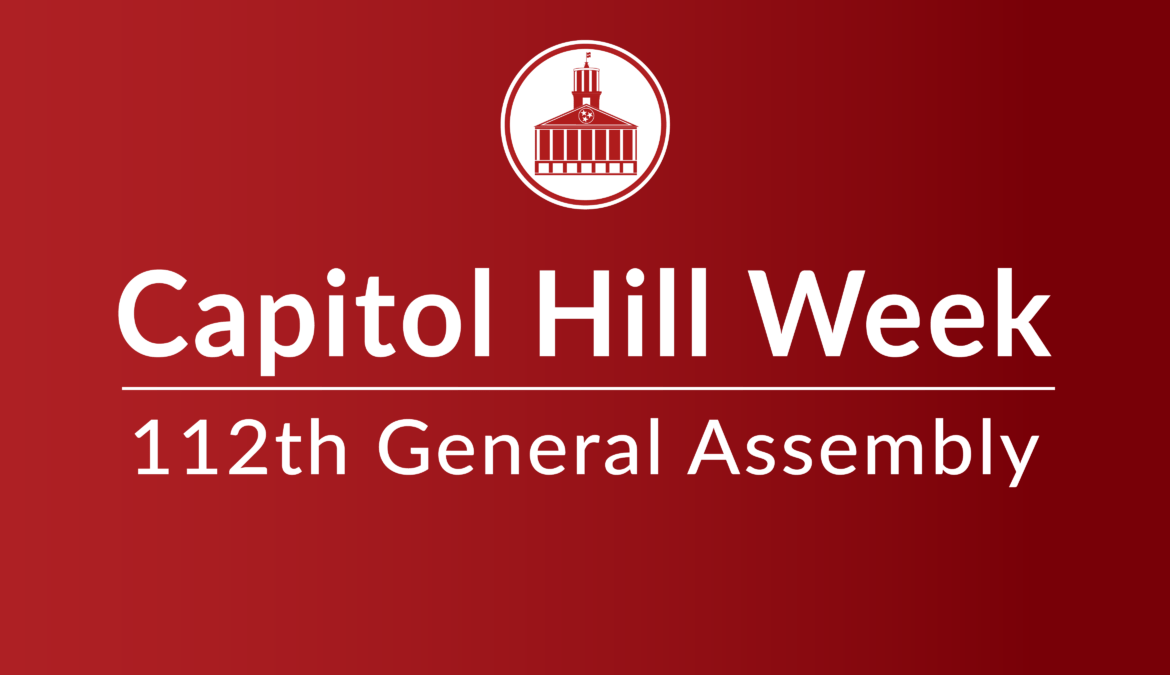The 112th General Assembly reconvened on Tuesday to kick off the 2022 legislative session. Redistricting, the state budget, tax relief, education funding, access to quality healthcare and mental health services, labor shortages and continuing the state’s robust job growth are among the wide variety of issues expected to be on the agenda this year. The following is a summary of the first week of session:
Redistricting maps clear committee
The Senate Ad Hoc Committee on Redistricting voted on Thursday to recommend both State Senate and Congressional redistricting maps to the Senate Judiciary Committee. The maps are expected to be voted on by the General Assembly next week.
“We worked very hard with this committee to make this process very transparent and I think we’ve ended up with fair and legal maps,” said Senate Majority Leader Jack Johnson (R-Franklin), who is also Chairman of the Ad Hoc Committee on Redistricting. “The public input was a critical component of what we did with this committee. We asked for public input, it was received, and we considered that input. … We also obviously consulted with all members of the General Assembly.”
Redistricting occurs every 10 years following the census. The purpose of redistricting is to ensure Tennesseans have equal representation. This right is rooted in both the federal and state constitutions and has been ruled upon by the courts numerous times. The most famous case is the landmark U.S. Supreme Court decision in Tennessee’s Baker v. Carr, which led to the “one man – one vote” standard used in redistricting nationwide.
The new Senate map balances the federal mandate of “one person, one vote” with the state constitutional mandate not to split counties. The map has a historically low deviation among districts — 6.17% — with only nine county splits. No incumbents are paired together, and current district boundaries were disturbed as little as possible.
The new Congressional map adheres to the constitutional mandate of “one person, one vote” and splits just nine counties. In accordance with the Voting Rights Act, the map preserves the 9th District as a majority-minority district, and no incumbents are paired together.
Population increases in and around Davidson County have made splitting the county a logical move to manage growth. There is also precedence for doing so. The last two Democrat-drawn maps in 2002 and 1992 split Davidson County in two. In the 1990s, Congressman Bart Gordon represented a portion of Davidson County, and in the 2000s, Congressman Blackburn represented a portion of the county. Democrats have also split both Shelby County and Knox County three ways at various points in history.
“I am proud of the work the Senate Ad-Hoc Committee on Redistricting has done. Despite a compressed timeframe due to the late release of census data, the committee conducted an open and transparent process that solicited and considered input from all Senators and the general public,” said Lt. Governor Randy McNally (R-Oak Ridge). “The recommended maps are fair and legal, disturb no currently serving legislator and preserve, as much as possible, current district composition. Despite challenging and contradictory state and federal mandates, this committee managed to keep both population deviation and county splits to historic lows. An excellent work product to hand off to the Senate Judiciary Committee as this process continues.”
Tennessee expected to see higher than budgeted revenues this fiscal year
Tax revenue is expected to continue growing in Tennessee to $3.18 billion over budgeted estimates this fiscal year, according to the Fiscal Review Committee. It presented on the state’s fiscal outlook before the Senate Finance, Ways and Means Committee Tuesday.
In the first four months of the current fiscal year, collections have increased over the same period last year by 21.8%, and have exceeded current budgeted targets by over 25% or $1.2 billion, said Fiscal Review Committee Director Bojan Savic.
The Fiscal Review Committee is estimating total current year growth of 8.8%, and fiscal year 2023 growth of 4.85%.
Savic noted inflation continues to be a concern as supply chain issues and energy costs have contributed to higher prices, but pent-up demand and business and population growth continue to drive growth in tax collection.
Chief Economist Joe Wegenka said the state has seen improving employment numbers, but noted total employment remains relatively low due to labor force participation.
“Most sectors have improved to pre-pandemic levels,” he said. “Education and health services are still down slightly, leisure and hospitality has recovered quite a bit, but there are still about 32,000 jobs fewer than before the pandemic.”
In Brief…
Highway Safety — The Senate Transportation and Safety Committee heard testimony from Tennessee Highway Patrol Colonel Matt Perry this week regarding their efforts to make the state’s roads safer. Perry said the department is focusing on getting more troopers on the roads as they increase visibility after an escalation in fatal crashes in 2021. Perry said speed, failure to yield the right of way, distracted and impaired driving were the primary reasons for the increase. The department is actively recruiting new highway troopers, including experienced officers from other states that will be in the field more quickly. After a basic training program and on-the-job field training, the troopers will be prepared to protect the public as they travel on Tennessee’s roads.
Alternative Fuel Corridors – Tennessee is making significant progress in the identification, planning and designation of alternative fuel corridors in Tennessee, according to Department of Transportation Deputy Commissioner Preston Elliott. He told lawmakers this week that the Volunteer State is ranked first in the Southeast for alternative fuels or electric vehicle (EV) projects and investments with four automotive manufacturers in the state. The Tennessee Department of Transportation has been working collaboratively within and outside the state to provide a diversity of alternative fuel options for the traveling public. This includes partnering with the Tennessee Department of Environment and Conservation, Tennessee Valley Authority (TVA) and surrounding states to move forward with this initiative. The designation of alternative fuel corridors positions Tennessee to acquire significant federal funding, which is available for this purpose. In addition to electric vehicles, alternative fuels include liquid petroleum gas (LPG), compressed natural gas (CNG), liquid natural gas (LNG) and hydrogen (HYD).
Road Safety / Snow and Ice — The Tennessee Department of Transportation (TDOT) remains ready to meet the challenges of snow and ice on state roads as winter weather threatens safe travel. TDOT’s statewide 2021-2022 winter weather budget is $25.6 million, according to Deputy Commissioner and Chief Engineer Paul Degges, who testified before the Senate Transportation and Safety Committee. He said there are salt bins in all 95 Tennessee counties to meet future needs as the department works closely with other state agencies to complement emergency services in inclement weather. TDOT can also procure the services of local contractors to help clear roads and keep the public safe. TDOT is looking at improving shift work, as well as utilizing other resources like technology to detect road surface temperatures to expedite the cleaning of roads.
Federal Transportation Infrastructure Bill – The Senate Transportation and Safety Committee heard testimony on Wednesday that the new Infrastructure Investment and Jobs Act (IIJA) authorized by Congress will appropriate about $1.7 billion more than the previous federal transportation bill for Tennessee over a five-year period. This includes $1 billion for Tennessee’s core road and bridge programs, and $0.7 billion in new programs such as carbon/green initiatives and electric vehicle infrastructure. TDOT Interim Commissioner and Chief Financial Officer Joe Galbato said there are many unknowns regarding set asides or how these funds can be used.
The funds are substantially less than the additional $6.2 billion being touted by IIJA supporters. Tennessee already receives $4.5 billion under the previous Fast Act highway funding program.
The five-year IIJA required a transfer of $118 billion to keep the highway transportation fund (HTF) solvent. Congress did not take action to address a long-term sustainable solution for revenue shortfall. According to the Congressional Budget Office, the IIJA will add $256 billion to projected deficits over the 2021-2031 period, thus likely contributing to inflation.
As further guidance from the federal government is released, the responsible use of these federal dollars will be a top issue for the Transportation and Safety Committee as well the Finance, Ways and Means Committee this year.
Tennessee higher education funding formula — Tennessee remains the only state that funds its public higher education institutions based solely on outcomes. That’s according to a presentation by Dr. Emily House, executive director of the Tennessee Higher Education Commission, who appeared before the Senate Education Committee Wednesday.
Funds are allocated based on a formula that is thoroughly reviewed every five years by the Tennessee Higher Education Commission. For 2021-2025, the commission is recommending the following changes:
- Inclusion of a focus population premium for undergraduate awards in high-need fields
- Remove activities provided by trainers who received their training at the reporting college
- Reduce the influence of fixed costs (e.g., M&O, rent, equipment) on the outcomes-based funding formula
- Recognize out-of-state, low-income students as we recognize out-of-state students in all other outcomes/focus populations
Biosimilars — The Senate Health and Welfare Committee on Wednesday took in a presentation about biosimilars and their savings potential in Tennessee. According to the FDA, a biosimilar product is a biological product that is highly similar to and has no clinically meaningful differences from an existing FDA-approved reference product. In the simplest terms, biosimilars are a generic of a biologic drug, which are medicines made from living organisms, said Fran Gregory, executive director of the pharmaceutical company Sandoz. There are currently just 33 FDA-approved biosimilars in the United States, but that number is growing every month, she added.
In her presentation, Gregory said biosimilars, if widely adopted, could save the United States healthcare system $183 billion over the next five years. In Tennessee, if the biosimilars that are currently on the market were utilized 70% of the time over the reference product, the state would save an estimated $390 million per year, she said.


